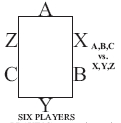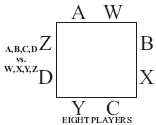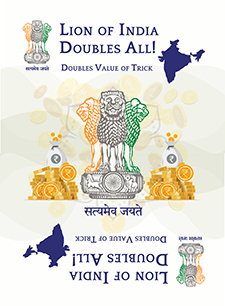Make-A-Million Rupees | Rules of the Game
Designed for 4 players.
Two teams composed of two players each.
You may download a PDF of our Rule Booklet if you prefer.
- Click here for rules for 6 or 8 players (requires 2 decks) -
4 Player Rules
Objective:
To capture tricks in which Money cards have been played. Partners work together to take as many tricks containing Money cards as possible. The side to first score a million Rupees wins.
Dealing:
Players from the same team sit across from one another when playing as “fixed partners” but there is a variant of the game whereby you may “call” your partner who holds a desired card (such as the Bengal Tiger Takes All) and does not reveal his/her identity until that card is played. After each hand, the deal passes to the left. The dealer distributes the entire pack, randomly placing three cards aside to form the “widow” (purpose explained later).
Bidding:
Players bid for the privilege of choosing the trump color. The player to the left of the dealer begins the bid and may begin at or greater than ₹175,000, and the highest bid is usually from ₹220,000 to ₹260,000. Each subsequent bid must be at least ₹10,000 higher than the previous bid. Thus, following a starting bid of ₹175,000, bids such as ₹185,000, ₹200,000, ₹210,000, are proper. The bid then continues clockwise, and each player must make a bid or pass. This process continues until everybody except one player has passed.
Note: The highest possible score for one hand is ₹400,000 plus/minus what the Lion of India or Bear cards may double or cancel.
The widow goes to the highest bidder, who also names the trump color. The highest bidder then takes the widow of three cards. He may retain any or all of these in his hand, and then must discard three unwanted cards in their place. He must not discard a Money card unless there are no other non-Money cards to discard—in which case he must show the Money cards he discards to other players. He must never discard The Bengal Tiger, Lion of India and Bear Trump cards. The highest bidder then announces the color of trumps.
The Trump Cards:
You may download a PDF of our Rule Booklet if you prefer.
- Click here for rules for 6 or 8 players (requires 2 decks) -
To capture tricks in which Money cards have been played. Partners work together to take as many tricks containing Money cards as possible. The side to first score a million Rupees wins.
Dealing:
Players from the same team sit across from one another when playing as “fixed partners” but there is a variant of the game whereby you may “call” your partner who holds a desired card (such as the Bengal Tiger Takes All) and does not reveal his/her identity until that card is played. After each hand, the deal passes to the left. The dealer distributes the entire pack, randomly placing three cards aside to form the “widow” (purpose explained later).
Bidding:
Players bid for the privilege of choosing the trump color. The player to the left of the dealer begins the bid and may begin at or greater than ₹175,000, and the highest bid is usually from ₹220,000 to ₹260,000. Each subsequent bid must be at least ₹10,000 higher than the previous bid. Thus, following a starting bid of ₹175,000, bids such as ₹185,000, ₹200,000, ₹210,000, are proper. The bid then continues clockwise, and each player must make a bid or pass. This process continues until everybody except one player has passed.
Note: The highest possible score for one hand is ₹400,000 plus/minus what the Lion of India or Bear cards may double or cancel.
The widow goes to the highest bidder, who also names the trump color. The highest bidder then takes the widow of three cards. He may retain any or all of these in his hand, and then must discard three unwanted cards in their place. He must not discard a Money card unless there are no other non-Money cards to discard—in which case he must show the Money cards he discards to other players. He must never discard The Bengal Tiger, Lion of India and Bear Trump cards. The highest bidder then announces the color of trumps.
The Trump Cards:
The Lion of India card
The Lion of India card may be played only when its holder cannot play a card of the color led, or when it is the last card held in a player’s hand. It is a very important card because it doubles the value of the count cards in that trick for the side that captures it.
The Bear card
The Bear card may be played only when its holder cannot play a card of the color led, or when it is the last card held in a player’s hand. It cancels the value of the Money cards in that trick for the side that captures it. If the Lion of India and the Bear Trump cards are both played upon the same trick, the value of the trick is affected only by whichever is played last. If a player is forced to lead a trick with the The Lion of India or Bear card then the player who first follows with a number, Money card, or Bengal Tiger card establishes the color of that suit.
The Bengal Tiger card
The Bengal Tiger card is always the highest trump and is used like any card of the trump color. If led, it calls for the play of trumps. If trumps are led and the player with the
Bengal Tiger card has no other trumps in his hand, he has to play the Bengal Tiger card.
VARIATION:
Trump cards may be played at any time regardless of the color led. Playing: After the trump color is announced (and widow removed), the highest bidder begins game by playing any card of any color. Play passes to the left, each person playing one card. The highest card of the color led takes the cards thus played, called a trick, unless the trick is trumped - the highest trump played takes the trick.
Note: If the player has a card of the color led, he must play a card of that color.
If a player does not have a card of the Color led, he may either “throw away,” (i.e., play a card of any other color), or, he may in such case, play a trump card, if he has one.
Partners must not advise each other what to play.
Whoever takes a trick places it face-down in front of him so all captured tricks are kept in one group. Tricks containing Trump cards are kept separate from others. The player taking the trick leads the next trick. Trump cards cannot lead trick unless the player has no other cards left in their hand.
Scoring:
After all the cards of the hand have been played, each side adds up the score of the captured Money cards. Any Money cards in the trick in which the Lion of India is played count double, and the trick in which the Bear is played is worthless (subject, of course, to the rule regarding the play of both Lion of India and Bear in the same trick).
If the highest bidder’s side has captured cards that total or exceed its bid, it scores all it has earned. If the highest bidder’s side has failed to earn at least its bid, it is “set back” the total amount of its bid. It not only can’t score what it earned, but has the entire bid amount recorded as a negative score (deducted from its current or future earnings).
The opposing side, which did not name the trump color, retains the total amount it made.
The game is won by the side that first scores one million Rupees. If both sides reach or exceed one million Rupees at the end of the same hand, the highest score wins.
6-8 Player Rules | Return to Top
The same rules apply as in standard four player Make-a-Million Rupees, but players use combine two Make-a-Million Rupees decks. This doubles the possible total score, and the starting and high Bids.
The players remove extra cards not used in play:
For eight players
Remove three One cards from the decks
(i.e., a red One, Blue One, and green One).
For six players
Remove five number One cards from the decks
(i.e., a red One, green One, blue One, and both Green Ones).
Same rules apply as in standard four player Make-a-Million Rupees. Using two decks, there are now two of every card. If two players play the same card on the same trick, and that card would take the trick, the one played last takes the trick.
EXAMPLE (six players):

In chart above: A,B,C vs. X,Y,Z
A leads with a Green ₹40,000. X follows with a Green ₹10,000, hoping one of his partners (Y or Z) has the other Green ₹40,000, B cautiously plays a low Green card. Y plays the other Green ₹40,000. C plays a low Green card. Z plays a Green ₹30,000, Since Y played his Green ₹40,000 after A played his, Y wins the trick. LION AND BEAR: Same rules apply as in four-player Make-a-Million. If two Bulls are played on the same trick, the count of that trick is quadrupled (unless a bear was played after both Lions had been played). If a Lion is played, then a Bear, and then another Lion, and a Bear is not played again, the entire trick is reactivated and the count of that trick quadruples.
EXAMPLE (eight players):

In chart above: A,B,C,D vs. W,X,Y,Z
A leads with a Blue ₹40,000. W plays a low Blue card. B, out of black, plays the Lion. X, not wanting the opposing team to score and being out of Blue, plays Bear. C plays a low Blue card. Y, not on the Highest-Bidder's team, plays a Blue ₹30,000 hoping it is canceled. D, out of Blue, plays the other Lion. Z plays a low Blue card. A wins the trick and the count quadruples (₹70,000 x 4 = ₹280,000).
Silent partner
Silent partner Make-a-Million Rupees should be played with six or eight players. The same rules apply as in six or eight-player Make-a-Million Rupees, but partners are not necessarily every other Player.
After trump color is chosen and the Widow discarded, The Highest Bidder selects two (six players) or three (eight players) cards from his own hand and lays them face up on the table. The Lion, Bear, and Tiger must not be selected. The players who have the corresponding cards in their hands become partners of the Highest Bidder. The partners do not immediately reveal their partnership. This happens when they lay one of the cards that the Highest Bidder selected as a partner on a trick. Sometimes a player may have more than one of the partner cards selected by the Highest Bidder. This is the chance the Highest Bidder takes. The Highest Bidder must be careful not to select a partner card that he already holds the duplicate for in his hand.
Scoring:
With Silent Partner Make-a-Million Rupees, each player keeps his own score. The score received by the team is recorded for each player of that team.
EXAMPLE (six players):
A is the Highest Bidder at ₹480,000 and selects the player(s) holding the Red ₹40,000 and Green ₹40,000 as his partner(s). Y holds the Red ₹40,000 in his hand and is thus a partner with A. After the last trick is played the Highest Bidder counts the total amount captured by him and his partners. The count is ₹510,000. The amount of ₹510,000 is recorded for each individual partner of the Highest Bidder.
Partners must not advise each other what to play.
Whoever takes a trick places it face-down in front of him so all captured tricks are kept in one group. Tricks containing Trump cards are kept separate from others. The player taking the trick leads the next trick. Trump cards cannot lead trick unless the player has no other cards left in their hand.
Scoring:
After all the cards of the hand have been played, each side adds up the score of the captured Money cards. Any Money cards in the trick in which the Lion of India is played count double, and the trick in which the Bear is played is worthless (subject, of course, to the rule regarding the play of both Lion of India and Bear in the same trick).
If the highest bidder’s side has captured cards that total or exceed its bid, it scores all it has earned. If the highest bidder’s side has failed to earn at least its bid, it is “set back” the total amount of its bid. It not only can’t score what it earned, but has the entire bid amount recorded as a negative score (deducted from its current or future earnings).
The opposing side, which did not name the trump color, retains the total amount it made.
The game is won by the side that first scores one million Rupees. If both sides reach or exceed one million Rupees at the end of the same hand, the highest score wins.
6-8 Player Rules | Return to Top
The same rules apply as in standard four player Make-a-Million Rupees, but players use combine two Make-a-Million Rupees decks. This doubles the possible total score, and the starting and high Bids.
The players remove extra cards not used in play:
For eight players
Remove three One cards from the decks
(i.e., a red One, Blue One, and green One).
For six players
Remove five number One cards from the decks
(i.e., a red One, green One, blue One, and both Green Ones).
Same rules apply as in standard four player Make-a-Million Rupees. Using two decks, there are now two of every card. If two players play the same card on the same trick, and that card would take the trick, the one played last takes the trick.
EXAMPLE (six players):

In chart above: A,B,C vs. X,Y,Z
A leads with a Green ₹40,000. X follows with a Green ₹10,000, hoping one of his partners (Y or Z) has the other Green ₹40,000, B cautiously plays a low Green card. Y plays the other Green ₹40,000. C plays a low Green card. Z plays a Green ₹30,000, Since Y played his Green ₹40,000 after A played his, Y wins the trick. LION AND BEAR: Same rules apply as in four-player Make-a-Million. If two Bulls are played on the same trick, the count of that trick is quadrupled (unless a bear was played after both Lions had been played). If a Lion is played, then a Bear, and then another Lion, and a Bear is not played again, the entire trick is reactivated and the count of that trick quadruples.
EXAMPLE (eight players):

In chart above: A,B,C,D vs. W,X,Y,Z
A leads with a Blue ₹40,000. W plays a low Blue card. B, out of black, plays the Lion. X, not wanting the opposing team to score and being out of Blue, plays Bear. C plays a low Blue card. Y, not on the Highest-Bidder's team, plays a Blue ₹30,000 hoping it is canceled. D, out of Blue, plays the other Lion. Z plays a low Blue card. A wins the trick and the count quadruples (₹70,000 x 4 = ₹280,000).
Silent partner
Silent partner Make-a-Million Rupees should be played with six or eight players. The same rules apply as in six or eight-player Make-a-Million Rupees, but partners are not necessarily every other Player.
After trump color is chosen and the Widow discarded, The Highest Bidder selects two (six players) or three (eight players) cards from his own hand and lays them face up on the table. The Lion, Bear, and Tiger must not be selected. The players who have the corresponding cards in their hands become partners of the Highest Bidder. The partners do not immediately reveal their partnership. This happens when they lay one of the cards that the Highest Bidder selected as a partner on a trick. Sometimes a player may have more than one of the partner cards selected by the Highest Bidder. This is the chance the Highest Bidder takes. The Highest Bidder must be careful not to select a partner card that he already holds the duplicate for in his hand.
Scoring:
With Silent Partner Make-a-Million Rupees, each player keeps his own score. The score received by the team is recorded for each player of that team.
EXAMPLE (six players):
A is the Highest Bidder at ₹480,000 and selects the player(s) holding the Red ₹40,000 and Green ₹40,000 as his partner(s). Y holds the Red ₹40,000 in his hand and is thus a partner with A. After the last trick is played the Highest Bidder counts the total amount captured by him and his partners. The count is ₹510,000. The amount of ₹510,000 is recorded for each individual partner of the Highest Bidder.
Scoring:
After all the cards of the hand have been played, each side adds up the score of the captured Money cards. Any Money cards in the trick in which the Lion of India is played count double, and the trick in which the Bear is played is worthless (subject, of course, to the rule regarding the play of both Lion of India and Bear in the same trick).
If the highest bidder’s side has captured cards that total or exceed its bid, it scores all it has earned. If the highest bidder’s side has failed to earn at least its bid, it is “set back” the total amount of its bid. It not only can’t score what it earned, but has the entire bid amount recorded as a negative score (deducted from its current or future earnings).
The opposing side, which did not name the trump color, retains the total amount it made.
The game is won by the side that first scores one million Rupees. If both sides reach or exceed one million Rupees at the end of the same hand, the highest score wins.
6-8 Player Rules | Return to Top
The same rules apply as in standard four player Make-a-Million Rupees, but players use combine two Make-a-Million Rupees decks. This doubles the possible total score, and the starting and high Bids.
The players remove extra cards not used in play:
For eight players
Remove three One cards from the decks
(i.e., a red One, Blue One, and green One).
For six players
Remove five number One cards from the decks
(i.e., a red One, green One, blue One, and both Green Ones).
Same rules apply as in standard four player Make-a-Million Rupees. Using two decks, there are now two of every card. If two players play the same card on the same trick, and that card would take the trick, the one played last takes the trick.
EXAMPLE (six players):

In chart above: A,B,C vs. X,Y,Z
A leads with a Green ₹40,000. X follows with a Green ₹10,000, hoping one of his partners (Y or Z) has the other Green ₹40,000, B cautiously plays a low Green card. Y plays the other Green ₹40,000. C plays a low Green card. Z plays a Green ₹30,000, Since Y played his Green ₹40,000 after A played his, Y wins the trick. LION AND BEAR: Same rules apply as in four-player Make-a-Million. If two Bulls are played on the same trick, the count of that trick is quadrupled (unless a bear was played after both Lions had been played). If a Lion is played, then a Bear, and then another Lion, and a Bear is not played again, the entire trick is reactivated and the count of that trick quadruples.
EXAMPLE (eight players):

In chart above: A,B,C,D vs. W,X,Y,Z
A leads with a Blue ₹40,000. W plays a low Blue card. B, out of black, plays the Lion. X, not wanting the opposing team to score and being out of Blue, plays Bear. C plays a low Blue card. Y, not on the Highest-Bidder's team, plays a Blue ₹30,000 hoping it is canceled. D, out of Blue, plays the other Lion. Z plays a low Blue card. A wins the trick and the count quadruples (₹70,000 x 4 = ₹280,000).
Silent partner
Silent partner Make-a-Million Rupees should be played with six or eight players. The same rules apply as in six or eight-player Make-a-Million Rupees, but partners are not necessarily every other Player.
After trump color is chosen and the Widow discarded, The Highest Bidder selects two (six players) or three (eight players) cards from his own hand and lays them face up on the table. The Lion, Bear, and Tiger must not be selected. The players who have the corresponding cards in their hands become partners of the Highest Bidder. The partners do not immediately reveal their partnership. This happens when they lay one of the cards that the Highest Bidder selected as a partner on a trick. Sometimes a player may have more than one of the partner cards selected by the Highest Bidder. This is the chance the Highest Bidder takes. The Highest Bidder must be careful not to select a partner card that he already holds the duplicate for in his hand.
Scoring:
With Silent Partner Make-a-Million Rupees, each player keeps his own score. The score received by the team is recorded for each player of that team.
EXAMPLE (six players):
A is the Highest Bidder at ₹480,000 and selects the player(s) holding the Red ₹40,000 and Green ₹40,000 as his partner(s). Y holds the Red ₹40,000 in his hand and is thus a partner with A. After the last trick is played the Highest Bidder counts the total amount captured by him and his partners. The count is ₹510,000. The amount of ₹510,000 is recorded for each individual partner of the Highest Bidder.
Return to Top
The same rules apply as in standard four player Make-a-Million Rupees, but players use combine two Make-a-Million Rupees decks. This doubles the possible total score, and the starting and high Bids.
The players remove extra cards not used in play:
For eight players
Remove three One cards from the decks
(i.e., a red One, Blue One, and green One).
For six players
Remove five number One cards from the decks
(i.e., a red One, green One, blue One, and both Green Ones).
Same rules apply as in standard four player Make-a-Million Rupees. Using two decks, there are now two of every card. If two players play the same card on the same trick, and that card would take the trick, the one played last takes the trick.
EXAMPLE (six players):

In chart above: A,B,C vs. X,Y,Z
A leads with a Green ₹40,000. X follows with a Green ₹10,000, hoping one of his partners (Y or Z) has the other Green ₹40,000, B cautiously plays a low Green card. Y plays the other Green ₹40,000. C plays a low Green card. Z plays a Green ₹30,000, Since Y played his Green ₹40,000 after A played his, Y wins the trick. LION AND BEAR: Same rules apply as in four-player Make-a-Million. If two Bulls are played on the same trick, the count of that trick is quadrupled (unless a bear was played after both Lions had been played). If a Lion is played, then a Bear, and then another Lion, and a Bear is not played again, the entire trick is reactivated and the count of that trick quadruples.
EXAMPLE (eight players):

In chart above: A,B,C,D vs. W,X,Y,Z
A leads with a Blue ₹40,000. W plays a low Blue card. B, out of black, plays the Lion. X, not wanting the opposing team to score and being out of Blue, plays Bear. C plays a low Blue card. Y, not on the Highest-Bidder's team, plays a Blue ₹30,000 hoping it is canceled. D, out of Blue, plays the other Lion. Z plays a low Blue card. A wins the trick and the count quadruples (₹70,000 x 4 = ₹280,000).
Silent partner
Silent partner Make-a-Million Rupees should be played with six or eight players. The same rules apply as in six or eight-player Make-a-Million Rupees, but partners are not necessarily every other Player.
After trump color is chosen and the Widow discarded, The Highest Bidder selects two (six players) or three (eight players) cards from his own hand and lays them face up on the table. The Lion, Bear, and Tiger must not be selected. The players who have the corresponding cards in their hands become partners of the Highest Bidder. The partners do not immediately reveal their partnership. This happens when they lay one of the cards that the Highest Bidder selected as a partner on a trick. Sometimes a player may have more than one of the partner cards selected by the Highest Bidder. This is the chance the Highest Bidder takes. The Highest Bidder must be careful not to select a partner card that he already holds the duplicate for in his hand.
Scoring:
With Silent Partner Make-a-Million Rupees, each player keeps his own score. The score received by the team is recorded for each player of that team.
EXAMPLE (six players):
A is the Highest Bidder at ₹480,000 and selects the player(s) holding the Red ₹40,000 and Green ₹40,000 as his partner(s). Y holds the Red ₹40,000 in his hand and is thus a partner with A. After the last trick is played the Highest Bidder counts the total amount captured by him and his partners. The count is ₹510,000. The amount of ₹510,000 is recorded for each individual partner of the Highest Bidder.
For eight players
Remove three One cards from the decks
(i.e., a red One, Blue One, and green One).
For six players
Remove five number One cards from the decks
(i.e., a red One, green One, blue One, and both Green Ones).
Same rules apply as in standard four player Make-a-Million Rupees. Using two decks, there are now two of every card. If two players play the same card on the same trick, and that card would take the trick, the one played last takes the trick.
EXAMPLE (six players):

In chart above: A,B,C vs. X,Y,Z
A leads with a Green ₹40,000. X follows with a Green ₹10,000, hoping one of his partners (Y or Z) has the other Green ₹40,000, B cautiously plays a low Green card. Y plays the other Green ₹40,000. C plays a low Green card. Z plays a Green ₹30,000, Since Y played his Green ₹40,000 after A played his, Y wins the trick. LION AND BEAR: Same rules apply as in four-player Make-a-Million. If two Bulls are played on the same trick, the count of that trick is quadrupled (unless a bear was played after both Lions had been played). If a Lion is played, then a Bear, and then another Lion, and a Bear is not played again, the entire trick is reactivated and the count of that trick quadruples.
EXAMPLE (eight players):

In chart above: A,B,C,D vs. W,X,Y,Z
A leads with a Blue ₹40,000. W plays a low Blue card. B, out of black, plays the Lion. X, not wanting the opposing team to score and being out of Blue, plays Bear. C plays a low Blue card. Y, not on the Highest-Bidder's team, plays a Blue ₹30,000 hoping it is canceled. D, out of Blue, plays the other Lion. Z plays a low Blue card. A wins the trick and the count quadruples (₹70,000 x 4 = ₹280,000).
Silent partner
Silent partner Make-a-Million Rupees should be played with six or eight players. The same rules apply as in six or eight-player Make-a-Million Rupees, but partners are not necessarily every other Player.
After trump color is chosen and the Widow discarded, The Highest Bidder selects two (six players) or three (eight players) cards from his own hand and lays them face up on the table. The Lion, Bear, and Tiger must not be selected. The players who have the corresponding cards in their hands become partners of the Highest Bidder. The partners do not immediately reveal their partnership. This happens when they lay one of the cards that the Highest Bidder selected as a partner on a trick. Sometimes a player may have more than one of the partner cards selected by the Highest Bidder. This is the chance the Highest Bidder takes. The Highest Bidder must be careful not to select a partner card that he already holds the duplicate for in his hand.
Scoring:
With Silent Partner Make-a-Million Rupees, each player keeps his own score. The score received by the team is recorded for each player of that team.
EXAMPLE (six players):
A is the Highest Bidder at ₹480,000 and selects the player(s) holding the Red ₹40,000 and Green ₹40,000 as his partner(s). Y holds the Red ₹40,000 in his hand and is thus a partner with A. After the last trick is played the Highest Bidder counts the total amount captured by him and his partners. The count is ₹510,000. The amount of ₹510,000 is recorded for each individual partner of the Highest Bidder.

In chart above: A,B,C vs. X,Y,Z
A leads with a Green ₹40,000. X follows with a Green ₹10,000, hoping one of his partners (Y or Z) has the other Green ₹40,000, B cautiously plays a low Green card. Y plays the other Green ₹40,000. C plays a low Green card. Z plays a Green ₹30,000, Since Y played his Green ₹40,000 after A played his, Y wins the trick. LION AND BEAR: Same rules apply as in four-player Make-a-Million. If two Bulls are played on the same trick, the count of that trick is quadrupled (unless a bear was played after both Lions had been played). If a Lion is played, then a Bear, and then another Lion, and a Bear is not played again, the entire trick is reactivated and the count of that trick quadruples.
EXAMPLE (eight players):

In chart above: A,B,C,D vs. W,X,Y,Z
A leads with a Blue ₹40,000. W plays a low Blue card. B, out of black, plays the Lion. X, not wanting the opposing team to score and being out of Blue, plays Bear. C plays a low Blue card. Y, not on the Highest-Bidder's team, plays a Blue ₹30,000 hoping it is canceled. D, out of Blue, plays the other Lion. Z plays a low Blue card. A wins the trick and the count quadruples (₹70,000 x 4 = ₹280,000).
Silent partner
Silent partner Make-a-Million Rupees should be played with six or eight players. The same rules apply as in six or eight-player Make-a-Million Rupees, but partners are not necessarily every other Player.
After trump color is chosen and the Widow discarded, The Highest Bidder selects two (six players) or three (eight players) cards from his own hand and lays them face up on the table. The Lion, Bear, and Tiger must not be selected. The players who have the corresponding cards in their hands become partners of the Highest Bidder. The partners do not immediately reveal their partnership. This happens when they lay one of the cards that the Highest Bidder selected as a partner on a trick. Sometimes a player may have more than one of the partner cards selected by the Highest Bidder. This is the chance the Highest Bidder takes. The Highest Bidder must be careful not to select a partner card that he already holds the duplicate for in his hand.
Scoring:
With Silent Partner Make-a-Million Rupees, each player keeps his own score. The score received by the team is recorded for each player of that team.
EXAMPLE (six players):
A is the Highest Bidder at ₹480,000 and selects the player(s) holding the Red ₹40,000 and Green ₹40,000 as his partner(s). Y holds the Red ₹40,000 in his hand and is thus a partner with A. After the last trick is played the Highest Bidder counts the total amount captured by him and his partners. The count is ₹510,000. The amount of ₹510,000 is recorded for each individual partner of the Highest Bidder.

In chart above: A,B,C,D vs. W,X,Y,Z
A leads with a Blue ₹40,000. W plays a low Blue card. B, out of black, plays the Lion. X, not wanting the opposing team to score and being out of Blue, plays Bear. C plays a low Blue card. Y, not on the Highest-Bidder's team, plays a Blue ₹30,000 hoping it is canceled. D, out of Blue, plays the other Lion. Z plays a low Blue card. A wins the trick and the count quadruples (₹70,000 x 4 = ₹280,000).
Silent partner
Silent partner Make-a-Million Rupees should be played with six or eight players. The same rules apply as in six or eight-player Make-a-Million Rupees, but partners are not necessarily every other Player.
After trump color is chosen and the Widow discarded, The Highest Bidder selects two (six players) or three (eight players) cards from his own hand and lays them face up on the table. The Lion, Bear, and Tiger must not be selected. The players who have the corresponding cards in their hands become partners of the Highest Bidder. The partners do not immediately reveal their partnership. This happens when they lay one of the cards that the Highest Bidder selected as a partner on a trick. Sometimes a player may have more than one of the partner cards selected by the Highest Bidder. This is the chance the Highest Bidder takes. The Highest Bidder must be careful not to select a partner card that he already holds the duplicate for in his hand.
Scoring:
With Silent Partner Make-a-Million Rupees, each player keeps his own score. The score received by the team is recorded for each player of that team.
EXAMPLE (six players):
A is the Highest Bidder at ₹480,000 and selects the player(s) holding the Red ₹40,000 and Green ₹40,000 as his partner(s). Y holds the Red ₹40,000 in his hand and is thus a partner with A. After the last trick is played the Highest Bidder counts the total amount captured by him and his partners. The count is ₹510,000. The amount of ₹510,000 is recorded for each individual partner of the Highest Bidder.
After trump color is chosen and the Widow discarded, The Highest Bidder selects two (six players) or three (eight players) cards from his own hand and lays them face up on the table. The Lion, Bear, and Tiger must not be selected. The players who have the corresponding cards in their hands become partners of the Highest Bidder. The partners do not immediately reveal their partnership. This happens when they lay one of the cards that the Highest Bidder selected as a partner on a trick. Sometimes a player may have more than one of the partner cards selected by the Highest Bidder. This is the chance the Highest Bidder takes. The Highest Bidder must be careful not to select a partner card that he already holds the duplicate for in his hand.



